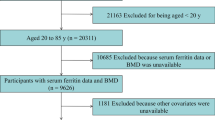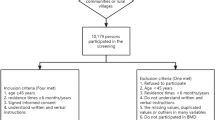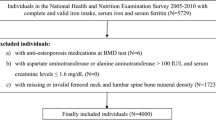Abstract
Summary
Data gathered from a nationally representative cohort demonstrate that higher serum ferritin levels are significantly associated with lower bone mass at various skeletal sites and the increased prevalence of osteoporosis and fractures, especially in women ≥45 years of age.
Introduction
Despite extensive in vitro and in vivo studies showing the detrimental effects of iron on bone metabolism, the clinical studies relating to osteoporosis-related phenotypes have not been evaluated extensively. In the present study, we investigated and compared the association between serum ferritin and bone mineral density (BMD), depending on the stratified age groups in both genders.
Methods
This is a population-based, cross-sectional study from the Korea National Health and Nutrition Examination Surveys, including 14,017 Koreans (6,817 men and 7,200 women) aged 10–80 years. BMD was measured using dual X-ray absorptiometry, and osteoporosis was diagnosed by the World Health Organization definition.
Results
Initially, we divided the subjects into three age groups, based on the patterns of age-related BMD changes in this national cohort (i.e., ≤24, 25–44, and ≥45 years old). Serum ferritin concentrations were inversely associated with BMD values at all measured sites after adjustment for confounders, only in women ≥45 years of age (P = 0.041 to <0.001). Furthermore, when we divided these women into serum ferritin quartiles, the odds for prevalent osteoporosis and fractures were 1.55-fold (95 % CI = 1.09–2.23) and 1.52-fold (95 % CI = 1.02–2.27) higher, respectively, in subjects in the highest quartile compared with those in the lowest quartile.
Conclusions
These results provide the first clinical evidence that the associations between serum ferritin level and bone parameters could be the most prominent in women ≥45 years of age.



Similar content being viewed by others
References
McCord JM (1996) Effects of positive iron status at a cellular level. Nutr Rev 54:85–88
Andrews NC (1999) Disorders of iron metabolism. N Engl J Med 341:1986–1995
Wilson JG, Lindquist JH, Grambow SC, Crook ED, Maher JF (2003) Potential role of increased iron stores in diabetes. Am J Med Sci 325:332–339
Ishii KA, Fumoto T, Iwai K et al (2009) Coordination of PGC-1beta and iron uptake in mitochondrial biogenesis and osteoclast activation. Nat Med 15:259–266
Yamasaki K, Hagiwara H (2009) Excess iron inhibits osteoblast metabolism. Toxicol Lett 191:211–215
Yang Q, Jian J, Abramson SB, Huang X (2011) Inhibitory effects of iron on bone morphogenetic protein 2-induced osteoblastogenesis. J Bone Miner Res 26:1188–1196
Tsay J, Yang Z, Ross FP et al (2010) Bone loss caused by iron overload in a murine model: importance of oxidative stress. Blood 116:2582–2589
Vogiatzi MG, Macklin EA, Fung EB et al (2009) Bone disease in thalassemia: a frequent and still unresolved problem. J Bone Miner Res 24:543–557
Guggenbuhl P, Deugnier Y, Boisdet JF, Rolland Y, Perdriger A, Pawlotsky Y, Chales G (2005) Bone mineral density in men with genetic hemochromatosis and HFE gene mutation. Osteoporos Int 16:1809–1814
Sinigaglia L, Fargion S, Fracanzani AL, Binelli L, Battafarano N, Varenna M, Piperno A, Fiorelli G (1997) Bone and joint involvement in genetic hemochromatosis: role of cirrhosis and iron overload. J Rheumatol 24:1809–1813
Kim B-J, Ahn SH, Bae SJ, Kim EH, Lee S-H, Kim H-K, Choe JW, Koh J-M, Kim GS (2012) Iron overload accelerates bone loss in healthy postmenopausal women and middle-aged men: a 3-year retrospective longitudinal study. J Bone Miner Res 27:2279–2290
Kular J, Tickner J, Chim SM, Xu J (2012) An overview of the regulation of bone remodelling at the cellular level. Clin Biochem 45:863–873
The Division of Chronic Disease Surveillance, Korea Centers for Disease Control and Prevention (2008–2010) The Fourth and Fifth Korea National Health and Nutrition Examination Survey (KNHANES IV & V)
Halle M, Konig D, Berg A, Keul J, Baumstark MW (1997) Relationship of serum ferritin concentrations with metabolic cardiovascular risk factors in men without evidence for coronary artery disease. Atherosclerosis 128:235–240
Lee BK, Kim Y, Kim YI (2011) Association of serum ferritin with metabolic syndrome and diabetes mellitus in the South Korean general population according to the Korean National Health and Nutrition Examination Survey 2008. Metabolism 60:1416–1424
Schoeller DA, Tylavsky FA, Baer DJ et al (2005) QDR 4500A dual-energy X-ray absorptiometer underestimates fat mass in comparison with criterion methods in adults. Am J Clin Nutr 81:1018–1025
Kelly TL, Wilson KE, Heymsfield SB (2009) Dual energy X-ray absorptiometry body composition reference values from NHANES. PLoS One 4:e7038
Lee EY, Kim D, Kim KM, Kim KJ, Choi HS, Rhee Y, Lim SK (2012) Age-related bone mineral density patterns in Koreans (KNHANES IV). J Clin Endocrinol Metab 97:3310–3318
Myong JP, Kim HR, Choi SE, Koo JW (2012) Dose-related effect of urinary cotinine levels on bone mineral density among Korean females. Osteoporos Int. doi:10.1007/s00198-012-2107-6
Ettinger B, Black DM, Nevitt MC, Rundle AC, Cauley JA, Cummings SR, Genant HK (1992) Contribution of vertebral deformities to chronic back pain and disability. The Study of Osteoporotic Fractures Research Group. J Bone Miner Res 7:449–456
Kleerekoper M, Nelson DA, Peterson EL, Tilley BC (1992) Outcome variables in osteoporosis trials. Bone 13(Suppl 1):S29–S34
Siminoski K, Jiang G, Adachi JD et al (2005) Accuracy of height loss during prospective monitoring for detection of incident vertebral fractures. Osteoporos Int 16:403–410
Drake MT, Khosla S (2012) Male osteoporosis. Endocrinol Metab Clin North Am 41:629–641
Baim S, Binkley N, Bilezikian JP, Kendler DL, Hans DB, Lewiecki EM, Silverman S (2008) Official Positions of the International Society for Clinical Densitometry and Executive Summary of the 2007 ISCD Position Development Conference. J Clin Densitom 11:75–91
Harrison PM, Arosio P (1996) The ferritins: molecular properties, iron storage function and cellular regulation. Biochim Biophys Acta 1275:161–203
Zacharski LR, Ornstein DL, Woloshin S, Schwartz LM (2000) Association of age, sex, and race with body iron stores in adults: analysis of NHANES III data. Am Heart J 140:98–104
Jiang R, Manson JE, Meigs JB, Ma J, Rifai N, Hu FB (2004) Body iron stores in relation to risk of type 2 diabetes in apparently healthy women. JAMA 291:711–717
Hong JS, Yi SW, Kang HC, Jee SH, Kang HG, Bayasgalan G, Ohrr H (2007) Age at menopause and cause-specific mortality in South Korean women: Kangwha Cohort Study. Maturitas 56:411–419
Greendale GA, Lee NP, Arriola ER (1999) The menopause. Lancet 353:571–580
Recker R, Lappe J, Davies K, Heaney R (2000) Characterization of perimenopausal bone loss: a prospective study. J Bone Miner Res 15:1965–1973
Sirola J, Kroger H, Honkanen R, Jurvelin JS, Sandini L, Tuppurainen MT, Saarikoski S (2003) Factors affecting bone loss around menopause in women without HRT: a prospective study. Maturitas 45:159–167
Kim CH, Kim HK, Bae SJ, Park JY, Lee KU (2011) Association of elevated serum ferritin concentration with insulin resistance and impaired glucose metabolism in Korean men and women. Metabolism 60:414–420
Feng X, McDonald JM (2011) Disorders of bone remodeling. Annu Rev Pathol 6:121–145
Raisz LG (2005) Pathogenesis of osteoporosis: concepts, conflicts, and prospects. J Clin Invest 115:3318–3325
Weitzmann MN, Pacifici R (2006) Estrogen deficiency and bone loss: an inflammatory tale. J Clin Invest 116:1186–1194
Hundrup YA, Høidrup S, Obel EB, Rasmussen NK (2004) The validity of self-reported fractures among Danish female nurses: comparison with fractures registered in the Danish National Hospital Register. Scand J Public Health 32:136–143
Ivers RQ, Cumming RG, Mitchell P, Peduto AJ (2002) The accuracy of self-reported fractures in older people. J Clin Epidemiol 55:452–457
Nevitt MC, Cummings SR, Browner WS, Seeley DG, Cauley JA, Vogt TM, Black DM (1992) The accuracy of self-report of fractures in elderly women: evidence from a prospective study. Am J Epidemiol 135:490–499
Green S, Anstiss CL, Fishman WH (1971) Automated differential isoenzyme analysis. II. The fractionation of serum alkaline phosphatases into "liver", "intestinal" and "other" components. Enzymologia 41:9–26
van Straalen JP, Sanders E, Prummel MF, Sanders GT (1991) Bone-alkaline phosphatase as indicator of bone formation. Clin Chim Acta 201:27–33
Koh JM, Khang YH, Jung CH, Bae S, Kim DJ, Chung YE, Kim GS (2005) Higher circulating hsCRP levels are associated with lower bone mineral density in healthy pre- and postmenopausal women: evidence for a link between systemic inflammation and osteoporosis. Osteoporos Int 16:1263–1271
Gabay C, Kushner I (1999) Acute-phase proteins and other systemic responses to inflammation. N Engl J Med 340:448–454
Jian J, Pelle E, Huang X (2009) Iron and menopause: does increased iron affect the health of postmenopausal women? Antioxid Redox Signal 11:2939–2943
Acknowledgments
This study was supported by a grant from the Korea Health Technology R&D Project, Ministry of Health & Welfare, Republic of Korea (project number A110536).
Conflicts of interest
None.
Author information
Authors and Affiliations
Corresponding author
Electronic supplementary material
Below is the link to the electronic supplementary material.
ESM 1
(JPEG 12 kb)
Rights and permissions
About this article
Cite this article
Kim, BJ., Lee, S.H., Koh, JM. et al. The association between higher serum ferritin level and lower bone mineral density is prominent in women ≥45 years of age (KNHANES 2008–2010). Osteoporos Int 24, 2627–2637 (2013). https://doi.org/10.1007/s00198-013-2363-0
Received:
Accepted:
Published:
Issue Date:
DOI: https://doi.org/10.1007/s00198-013-2363-0




